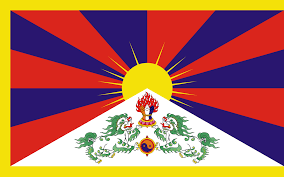Language/Tibetan/Vocabulary/Drinks
Hi Tibetan learners! 😊
In this lesson, we will learn some of the most common drinks in Tibetan, with their pronunciation and translation into English. We will also explore some cultural aspects related to drinking in Tibet.
Take a moment to explore these relevant pages as you conclude this lesson: Education, Animals, Geography & Directions.
Water[edit | edit source]
In Tibetan, "water" is ཆུ་བོ (chu bo). The pronunciation is [t͡ʃʰub̥o]. Water is essential for life and it has a special meaning in Tibetan culture. Tibet is called the "water tower of Asia" because it is the source of many major rivers in Asia, including the Yangtze, the Mekong, the Salween, and the Yellow River.
Dialogue[edit | edit source]
- Person 1: ཆུ་བོ་སྐྱེ་བ་བཏང་། (chu bo kyé wa tang?) - (Can I have a glass of water?)
- Person 2: ཁྱེད་ཀྱི་ཆུ་བོ མི་འདུག་། (kyé ki chu bo mi duk) - (Here is your water)
Butter tea[edit | edit source]
Butter tea, or བོད་ཇ་ (boed ja), is a traditional Tibetan drink made with tea leaves, yak butter, and salt. It is a high-calorie drink that is popular in Tibet, especially in rural areas where people need to stay warm. Yak butter is used because it is a good source of energy and it is available in rural areas. Butter tea is always served hot.
Dialogue[edit | edit source]
- Person 1: བོད་ཇ་རིག་འཛིན་བོད་བརྡ་རིགས་ཞུས་ལེགས་བྱེད་པའི་ཆས་དང་ཁོང་། (Boed ja rigdzin Bödré kyi ché dang khong?) - (Can I have a cup of butter tea with Bödré's picture on it?)
- Person 2: བོད་ཇ་ལེབ་སྟོན་དེ་བསླབ་པ་ཆེ་བ་(Boed ja lé ton de labpa ché ba) - (Here is your hot butter tea)
Chang[edit | edit source]
Chang, or ཆང་ (chang), is a traditional Tibetan alcoholic beverage. It is made from barley, water, and yeast. The fermentation process gives it a unique taste and aroma. Chang is usually served in wooden or ceramic bowls, and it is an important part of Tibetan social life. It is consumed during festivals, weddings, and other celebrations.
Dialogue[edit | edit source]
- Person 1: ཆང་གི་ཆས་འདི་ངེས་འཛིན་ཡག་པོ་བྱེད་པའི་མདོ་སྟེ་ག་རེ་གསལ་བཤད་པའི་གཉིས་ཏོག་ཏོ། (Chang gi ché di nes dzin yakpo kyé pa'i mdo ste ga re sal shé pa'i nyi tog to?) - (What is the proper way to serve chang?)
- Person 2: ཆང་གི་མདོ་སྟེ་ངེས་འཛིན་ཐོབ་ཐང་གི་ཡུལ་སྒྲུབ་པའི་ཕར་བར་སྤྲིན་བཏུབ་པ་ཡོད། (Chang gi mdo ste nes dzin tö tang gi yul grub pa'i par bar prin tub pa yo) - (The proper way to serve chang is to put it in a wooden or ceramic bowl and drink it with a straw)
Wine[edit | edit source]
Wine, or དབྱིན་ཚིག་ (jin tsik), is a popular drink in Tibet. It is made from grapes, and it is usually served at formal occasions or banquets. Wine has become more popular in recent years as a result of Chinese influence in Tibet.
Dialogue[edit | edit source]
- Person 1: དབྱིན་ཚིག་མར་དབྱིངས་གསུམ་པ་རེད། (jin tsik mar jing sum pa re?) - (What kind of wine do you have?)
- Person 2: སེང་གེ་དབྱིན་ཚིག་ལ་གསོ་བོ་བྱེད་པ་(Seng ge jin tsik la so bo kyé pa) - (We have a red wine)
Sweet tea[edit | edit source]
Sweet tea, or མདུང་བས་ཆ་ (dung sa cha), is a popular drink in Tibet. It is a sweet and milky tea that is made with black tea, milk, and sugar. It is usually served in small cups, and it is a popular drink among Tibetans and tourists.
Dialogue[edit | edit source]
- Person 1: མདུང་བས་ཆ་དེ་ངེས་པར་ཡོད་པ་(Dung sa cha de nes par yo pa?) - (How do you make sweet tea?)
- Person 2: ཆུ་མོ་འབད་པའི་ མདུང་བས་ཆ་ལ་བཉིས་རྒྱུད་བཟོ་བྱེད་པའི་ཚེ་གྲོང་ལ་གསོ་བོ་ཡོད་པ་(Chu mo bed pa'i dung sa cha la nyi gyu zó kyé pa'i tsé drong la so bo yo) - (We make sweet tea by boiling milk and sugar together with black tea, then adding a little butter)
Tea milk[edit | edit source]
Tea milk, or ཆ་མོ་ (cha mo) is a popular drink in Tibet. It is made by mixing black tea with milk, and it is usually served in small cups. It is a popular drink among Tibetans and visitors, and it is often used to welcome guests in Tibetan households.
Dialogue[edit | edit source]
- Person 1: ཆ་མོ་དང་གཅོད་པར་ཡོད་པ་(Cha mo dang chö par yo pa?) - (How do you make tea milk?)
- Person 2: ཆུ་མོ་་དང་མཐའ་ཡོད་པ་(Chu mo dang tsa yo pa) - (We make tea milk by mixing black tea with milk)
Conclusion[edit | edit source]
I hope you enjoyed this lesson on Tibetan drinks. Now you have expanded your Tibetan Vocabulary with new words related to drinking. Remember to practice your new vocabulary with native speakers and ask them any questions you may have! Drinking in Tibet is not only a way to quench your thirst, but it is also a cultural experience that reflects the traditions and customs of the Tibetan people. If you want to learn more about Tibetan culture, visit this page.
➡ If you have any questions, please ask them in the comments section below.
➡ Feel free to edit this wiki page if you think it can be improved. 😎
Sources[edit | edit source]
- Top 100 Basic Tibetan Phrases to know in Tibet • I Tibet Travel and ...
- Tibetan vocabulary: Kitchen utensils Flashcards | Quizlet
Now that you've completed this lesson, don't stop learning! Check out these related topics: Say Hello and Greetings in Tibetan, Fruits, Count to 10 & Health.
Other Lessons[edit | edit source]
- Animals
- Education
- Feelings and Emotions
- How to say Good Bye?
- Express Surprise
- Time
- Count to 10
- Health
- Colors
- Fruits

